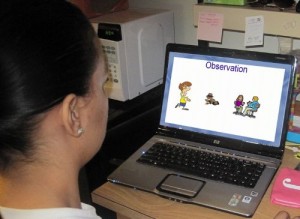Is the Flipped Classroom Moving Us Backwards?
 There is a lot of excitement over the concept of the flipped classroom, and rightly so. I remember sitting through many math lectures in high school that seemed to make sense, until I went home to try to do the homework. The next day our teacher would essentially re-teach the material, and then go through the confusing examples with us in class.
There is a lot of excitement over the concept of the flipped classroom, and rightly so. I remember sitting through many math lectures in high school that seemed to make sense, until I went home to try to do the homework. The next day our teacher would essentially re-teach the material, and then go through the confusing examples with us in class.
It could be great, if all kids follow through each night with homework, but lower achieving students are more likely not to, and that will further drive the two groups apart. Don’t get me wrong, I love the way Kahn academy is set up. But perhaps it’s better suited to use in the classroom to help differentiated instruction, or at home to allow stronger students to go ahead at their own pace.
I also think there is a fundamental misunderstanding of the purpose of flipping instruction. It’s not really a new way of learning,like problem based learning or game based learning. Rather, it’s a way to deliver the same kind of learning but make it more learner-centric by allowing the student to control the pace of learning. This is a very valuable change, in my opinion, and could definitely improve learning in nearly all classrooms that use flipped teaching – as long as expected outcomes are clear from the beginning.
As with any new program, before you start it helps to define your goals. Will this new program allow students to progress at their own pace? Will it encourage deeper learning? Will it encourage self directed learning? Will it allow students to follow their interests, regardless of type or depth of learning?
Also, it’s useful to outline how the goals will be measured – do you expect higher scores on standardized tests? Will scores on some other type of assessment go up? Will motivation increase? Will class participation go up? More homework get done?
There are many factors in a classroom that can be affected by changes in teaching, and there is no way to know whether the change is effective unless you know what it is supposed to be changing. The flipped classroom can be a great tool, but like any technology in the classroom it can widen the gap between students – or create new ones between different kinds of students – as well as decrease achievement gaps. Know how to provide help to students who may struggle with the new system, and provide alternatives for those who don’t respond to it.
To see success, define your goals, and set expectations accordingly.
Elisa teaches online professional development courses for teachers at teachertechtraining.com.
Register now for Teaching With Games - starts Monday January 4, 2016. Save $50 - Register by December 7, 2015!
Tags: Educational Video, flipped class, k-12, video in education




 A passion for creating educational multimedia, especially digital games. Fascinated by the challenge of integrating gameplay mechanics with educational content to create a true intrinsic learning experience. Interested in technology and special ed, digital storytelling, and science education. Closet science geek (shhh!!!)
A passion for creating educational multimedia, especially digital games. Fascinated by the challenge of integrating gameplay mechanics with educational content to create a true intrinsic learning experience. Interested in technology and special ed, digital storytelling, and science education. Closet science geek (shhh!!!)